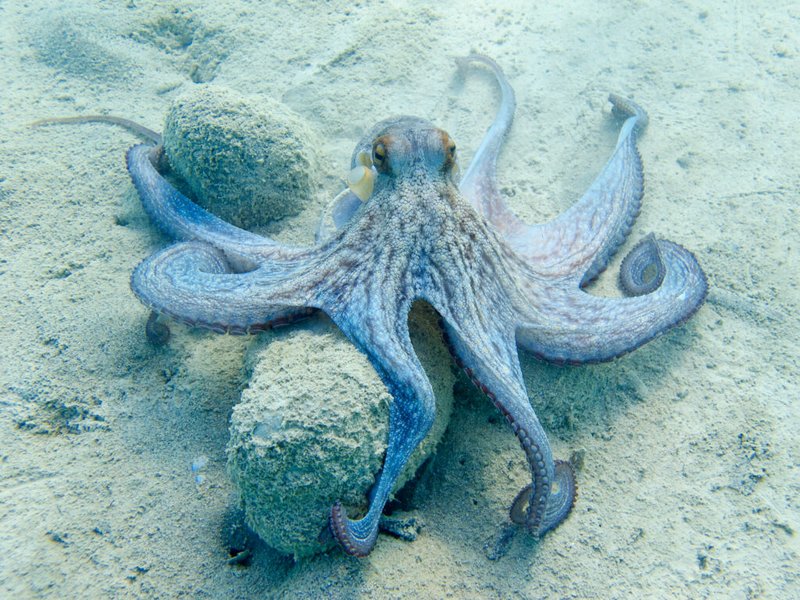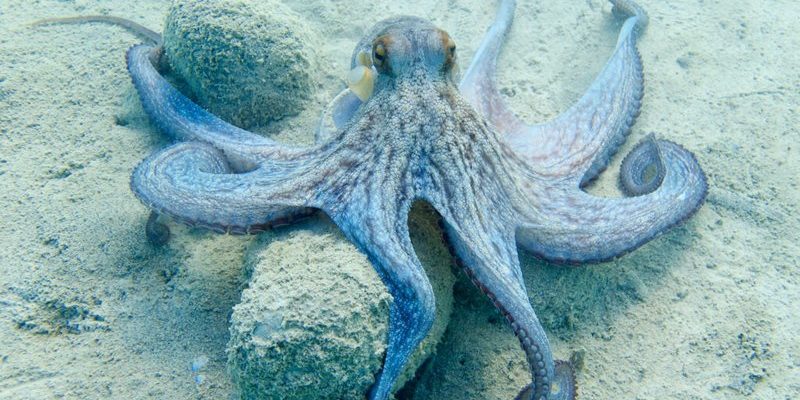
Let’s dive deeper into the fascinating world of the octopus. They live in various marine habitats, from coral reefs to deep-sea trenches, and their unique characteristics are just waiting to be explored. Whether you’re an ocean lover or just curious about these remarkable creatures, here are ten fun facts that will leave you even more enamored with the octopus.
1. Octopuses Have Three Hearts
Here’s the thing: octopuses are not just brainiacs of the deep; they’ve got a fascinating circulatory system as well. They actually have three hearts! Two of these hearts pump blood to the gills, where oxygen is picked up. The third heart then circulates this oxygen-rich blood to the rest of the body. Think of it as a three-lane highway, ensuring that each part of their body gets the oxygen needed to stay active and agile.
This unique setup makes them well-suited for life in water. However, when an octopus swims, the heart that delivers blood to the body stops beating temporarily. That’s why you’ll often see them prefer crawling instead of swimming, as it requires less energy. Isn’t it amazing how nature works?
2. Master of Disguise: Color and Texture Change
Octopuses are like living chameleons. They can change both their color and texture in seconds! This isn’t just for show; it’s all about survival. By changing colors, an octopus can blend in with its surroundings, making it harder for predators to spot them. They use special skin cells called chromatophores, which contain pigments that help them achieve this remarkable camouflage.
But wait, there’s more! Some species can even mimic the texture of their environment. Imagine an octopus turning its skin to resemble rough rocks or smooth sand. It’s a bit like putting on a costume for a fancy dress party, only they can change for real to escape danger or ambush prey. Pretty clever, right?
3. Intelligent Problem Solvers
Octopuses are not just physically adept; they’re also incredibly smart. They possess a level of intelligence that allows them to solve problems and even escape from enclosures. For instance, if an octopus finds itself trapped in a jar, it can figure out how to twist the lid open or squeeze itself through a small opening.
They have been observed using shells and coconut pieces as tools, demonstrating a form of tool use that many animals struggle with. Imagine being able to grab a tool from your environment to help you out when things get tough! That’s what makes octopuses such fascinating creatures. Their problem-solving abilities are a testament to their adaptability and intelligence in a complex underwater world.
4. Short Lifespan but Intense Reproduction
You might be surprised to learn that octopuses have a pretty short lifespan, typically ranging from just one to five years, depending on the species. This brevity is often tied to their reproductive cycle. After mating, a female octopus lays thousands of eggs and then dedicates her life to protecting them. Unfortunately, she stops eating during this time, leading to her death shortly after the eggs hatch.
It’s an intense and selfless process. You could say that the female octopus has a mission, and she’s laser-focused on ensuring the survival of her offspring. The eggs may take weeks to months to hatch, and during this time, she’ll guard them fiercely. This poignant sacrifice is both beautiful and heartbreaking, highlighting the fierce love of a mother in the animal kingdom.
5. Amazing Arm Strength
Did you know that an octopus has eight arms—not tentacles, but arms? Each arm is incredibly flexible and packed with muscles that allow for amazing strength and dexterity. An octopus can lift significant weights relative to its size, and each arm can move independently, giving it unparalleled maneuverability in the water.
Each arm has hundreds of sensitive suckers that help the octopus grip objects and taste its surroundings. They can even perform intricate actions like opening jars or letting go of a clam after cracking it open. It’s like having eight hands that can do their own thing, which is perfect for hunting and exploring the ocean floor.
6. The Blue Blood Mystery
Here’s something intriguing: octopuses have blue blood! You might be wondering why. Well, instead of hemoglobin, which makes our blood red, octopuses use a copper-rich protein called hemocyanin to transport oxygen. This makes their blood blue when oxygenated. The advantage? Hemocyanin is more efficient in cold, low-oxygen environments, like the deep ocean.
This fascinating adaptation allows octopuses to thrive in places where many other animals would struggle. It’s a brilliant example of how evolution shapes species to fit their environments. Who knew that a little change in blood color could have such significant benefits?
7. The Octopus’s Impressive Regeneration
If you lose an arm, it’s a big deal, right? Not for the octopus! These remarkable creatures can regenerate lost arms over time. Imagine if you could regrow your arm after a mishap. The process can take several months, but it’s a stunning display of nature’s resilience. They can also lose appendages intentionally to escape predators—a smart move!
When an octopus regrows an arm, it doesn’t just look the same; it functions just like the original. This regeneration ability helps them adapt and survive in the wild, where dangers can lurk around every corner. It’s a bit like nature’s own superhero power!
8. They Have a Unique Eating Style
An octopus’s diet can include fish, crabs, and other shellfish. But here’s where it gets interesting: an octopus doesn’t have a traditional mouth like we do. Instead, they have a beak, similar to a parrot’s, which they use to crack open shells. It’s like having a built-in nutcracker!
Once they manage to crack open their prey, it’s time for dessert! They have a specialized organ called a radula—a tongue with tiny teeth that helps them scrape and eat flesh. This unique eating style is part of what makes octopuses such efficient hunters, allowing them to enjoy a wide variety of foods in their underwater homes.
9. No Bones, No Problem
Another cool fact about octopuses is that they have no bones! Yep, they are entirely soft-bodied. This lack of a skeleton gives them the remarkable ability to squeeze through tight spaces and crevices. You could see them darting through a rock or escaping from a predator’s grasp, making it seem like they’re made of liquid rather than solid matter.
This flexibility allows octopuses to hide in their surroundings and escape from dangers efficiently. They can fit into places that seem impossibly small, surprising both predators and prey alike. It’s a fantastic feature that proves, sometimes, not having a rigid structure can offer incredible advantages.
10. They Communicate in Unexpected Ways
Octopuses may not have vocal cords, but they’ve got some surprising ways of communicating. They utilize both color changes and body language to express themselves. For instance, a scared octopus may turn lighter in color, while a more dominant one may display bright hues to appear more intimidating.
They also employ postures and movements, like puffing up or spreading their arms, to send signals to other creatures. Picture a dancer using gestures and colors to tell a story—that’s how octopuses interact with their world. It’s a beautiful reminder that communication can go beyond words.
In conclusion, there’s so much more to octopuses than meets the eye. From their remarkable intelligence to their ability to regenerate and adapt, these ocean wonders continue to captivate our imaginations. Exploring the depths of the ocean might reveal even more surprises waiting to be discovered! So next time you’re by the shore or enjoying an aquarium, take a moment to appreciate the incredible octopus and all its fascinating facts.

